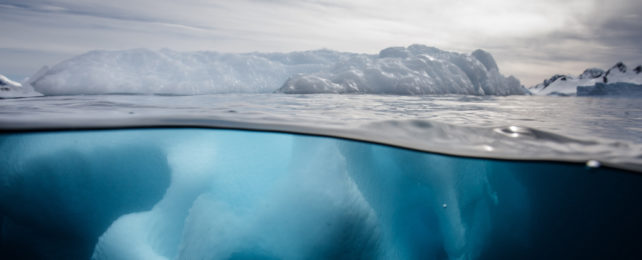The Southern Ocean's vast shelves of floating ice appear to hide sprawling blooms of phytoplankton, a discovery that could significantly change our understanding of Antarctica's marine ecosystem and how it might be impacted by climate change.
Key to phytoplankton growth is photosynthesis, and key to photosynthesis is sunlight – and so up to this point experts didn't think there was much opportunity for the plankton to thrive in the dark conditions under Antarctic ice shelves.
However, there have been recent discoveries of phytoplankton blooms under Arctic ice, created as the glaciers become more fragmented, more seasonal, thinner, and more susceptible to melting water. That prompted researchers to take a fresh look at Antarctica.
Field work was carried out using floating measuring instruments, with the collected data combined with satellite data of sea ice coverage and outputs from climate models to estimate the amount of phytoplankton that might extend beneath the ice, hidden from view.
"We found that nearly all examples of floats profiling under Antarctic sea ice record increases in phytoplankton before sea ice retreats," says polar oceanographer Christopher Horvat, from the University of Auckland in New Zealand.
"In many cases, we observed significant blooms."
These floats can take measurements independently and even take evasive action from approaching ice sheets when they sense near-freezing water temperatures. Here, they were tasked with measuring levels of the chlorophyll-a pigment and particulate backscatter, both indicators of phytoplankton.
Between 2014 and 2021, a total of 51 floats took measurements during 2,197 under-ice dives. This mass of data was then collected into 79 sequences of measurements for further analysis, while satellite imagery provided a record of ice cover.
"We found that 50 percent or more of the under-ice Antarctic might support under-ice blooms, because sea ice in the Southern Ocean is comprised of discrete floes, and small areas of open water permit light and therefore photosynthetic life," says Horvat.
Where complete and near-complete coverage of sea water could be recorded, 88 percent of the measured sequences recorded a rise in phytoplankton before any seasonal retreat of sea ice, which is when plankton growth tends to pick up considerably.
There is some uncertainty over the data due to occasional lag between sampling and position logging – uncertainty that future studies should remove – but the scientists behind the study say there's good, solid evidence that these blooms are happening.
As phytoplankton communities contain significant quantities of tiny algae, they typically represent the very bottom of the food chain in the ocean – variations in their availability and coverage can have a significant effect on the rest of the aquatic life in the area.
The next step for the researchers will be to gather even more data, and figure out how these plankton blooms might impact other forms of life under the ice. It should also aid our understanding of how less ice cover due to global warming will play out.
"Higher trophic levels migrate to where the productivity is, and if it is under the ice, one might expect the food web follows," says Horvat.
The research has been published in Frontiers in Marine Science.
